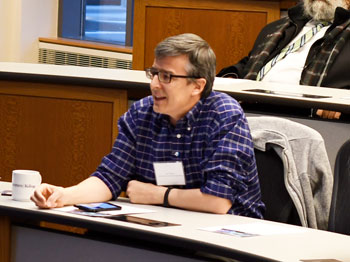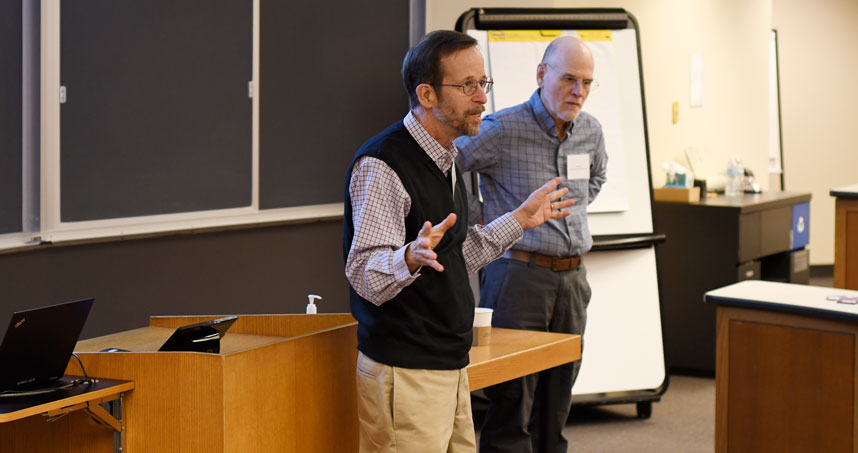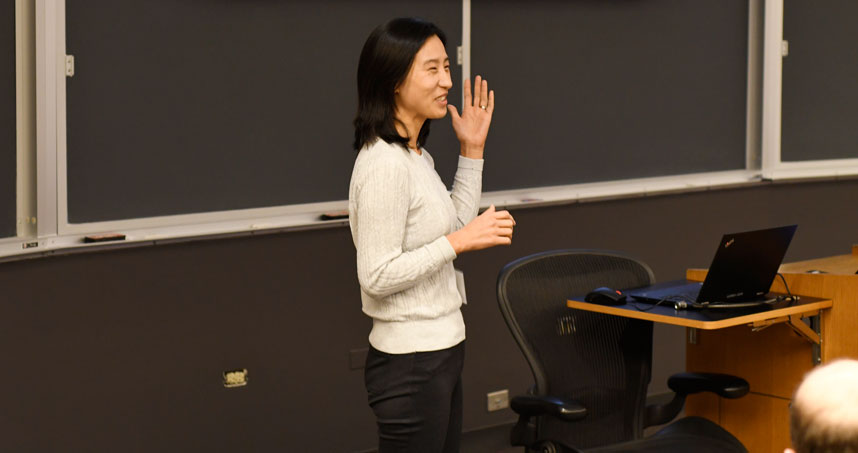Engineering Solutions for Children: Workshop Promotes Innovation in Pediatric Research
“Sensors and Sensing” took place on January 15
As a sociologist studying population health, Maryann Mason believes that a person’s adult health could be influenced by their activity patterns at a young age — very young.
Using accelerometers, video recordings, and journaling, Mason studied how soon high or low activity patterns develop in infants ranging in age from 3 to 9 months. She hoped the results could help researchers better understand health outcomes later in life.
Her work was among 10 presentations by engineers, medical professionals, and other researchers regarding advances in technology related to data capture and the clinical treatment of children at the January 15 workshop “Sensors and Sensing: Engineering Devices for Pediatric Research and Clinical Care.” Sponsored by Northwestern Engineering, the Northwestern University Clinical and Translational Sciences Institute, and Ann & Robert H. Lurie Children’s Hospital of Chicago, the event was held in the James L. Allen Center on Northwestern’s Evanston campus.
“We wanted to measure activity levels to determine cut points around active and inactive infants,” said Mason, research assistant professor of pediatrics and of preventative medicine at Northwestern University’s Feinberg School of Medicine. “We found that our method of measurement didn’t consider factors such as when a child was being carried, or the difference between sleep and inactivity. We’re looking for something better.”
Mason shared her challenge to an audience of nearly 50 mentors and trainees in engineering and pediatrics.
Aaron Hamvas, professor of pediatrics and chief of neonatology in the Department of Pediatrics at Feinberg, spoke about the technological challenges he sees caring for infants in the neonatal intensive care unit (NICU). To monitor vital measurements like temperature, blood pressure, and heart rate while in the NICU, doctors apply sticky patches and tubes connected to machines across the baby’s body. While necessary for the child’s health, the wires inhibit its natural movement while placing added stress on caregivers.
“It’s difficult for nurses to move them or for parents to hold them,” Hamvas said. “We’re looking for ways to potentially decrease the number of attachments on these babies.”
 Northwestern Engineering’s John Rogers continued the discussion by presenting his work on wearable and bio-integrated electronic devices. A pioneer in the field, he is currently developing a wireless, “tattoo-like” electronic patch to address these NICU constraints.
Northwestern Engineering’s John Rogers continued the discussion by presenting his work on wearable and bio-integrated electronic devices. A pioneer in the field, he is currently developing a wireless, “tattoo-like” electronic patch to address these NICU constraints.
“The idea is to make the wires go away, but not degrade any aspect of the fidelity and accuracy of the measurements that are enabled by these Band-Aid-like devices,” said Rogers, Louis Simpson and Kimberly Querrey Professor of Materials Science and Engineering, Biomedical Engineering, and Neurological Surgery.
Rogers’s device tracks all vital signs regularly measured in the NICU, including core body temperature, heart rate, and respiration rate. And because the sensor functions without wires, it requires less adhesive strength to adhere to the body, protecting the infant’s skin from scarring. Rogers’s team has launched a pilot study to test the sensor on nearly 100 babies.
Josiah Hester, assistant professor of computer engineering, discussed his efforts to create tiny, energy-harvesting computer systems that he believes hold broad-scale applications in medicine. Through his Ka Momoa Lab at Northwestern, Hester is building hardware, software, and algorithm platforms that function as healthcare monitoring devices without traditional batteries, making it easier to attain and measure sensory data on unique populations.
“Most people’s smartphones need to be plugged in once a day to charge. We’re trying to eliminate that aspect of dealing with devices,” Hester said. “Many populations, including pediatrics, can’t manage devices throughout the day, but we are still interested in the sensor readings and context of what they are doing.”
Among the projects Hester showcased is a necklace that tracks jaw movement to measure how often a person eats in a single day. Another project, called the Amulet smartwatch, features a nine-month battery life and provides an unobtrusive way for geriatric and teenage populations to measure multiple health readings, including sun exposure, activity, heart rate, and respiratory rate.
Other speakers included:
- Anna Fishbein, assistant professor of pediatrics at Feinberg, who discussed new approaches using chronomedicine and time-based treatments to improve outcomes for infants suffering from atopic dermatitis
- Matthew Grayson, professor of electrical and computer engineering, who shared research on novel sensors that are flexible and sensitive to pressure
- Soyang Kwon, research assistant professor of pediatrics at Feinberg, who discussed her goals to better monitor physical activity in infants
- Michael Peshkin, professor of mechanical engineering, who discussed how haptics technology could change how people interact with electronic devices
- Kris Razma, manager of occupational therapy at Lurie Children’s Hospital, who explained the challenges of applying adult medical devices to pediatrics
- John Walkup, professor of psychiatry and behavioral sciences at Feinberg, who shared how engineering solutions could help improve outcomes in neuropsychiatric care



